

Teachers, It’s Time We Appreciate Ourselves. Teacher Appreciation Day used to be agonizing.
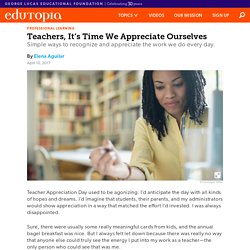
I’d anticipate the day with all kinds of hopes and dreams. I’d imagine that students, their parents, and my administrators would show appreciation in a way that matched the effort I’d invested. I was always disappointed. Sure, there were usually some really meaningful cards from kids, and the annual bagel breakfast was nice. 7 Self-Care Strategies For Teachers. This is a sampling of ideas for self-care taken from the Edutopia community.
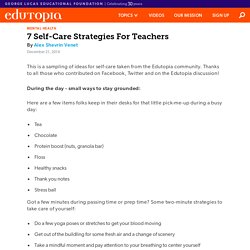
Thanks to all those who contributed on Facebook, Twitter and on the Edutopia discussion! During the day - small ways to stay grounded: Here are a few items folks keep in their desks for that little pick-me-up during a busy day: Teacher Self-Care: Are These Essential Actions Part of Your Routine? Teacher self-care is one of the current buzz phrases floating around in the teaching profession.

As individuals in positions of service, educators often put others’ needs ahead of their own. While admirable, this setup can eventually lead to… AnxietyFrustrationUnbearable stressResentmentAngerDepressionIrrational jealousyBitternessBURNOUT …just to name a few unappealing traits. Because of this, it’s especially important that teachers take necessary time for themselves. How to Build Emotional Supports for K-12 Teachers. In 2013, the State of America’s Schools Report found that teaching is one of the most stressful occupations in the United States, tied only with nursing.
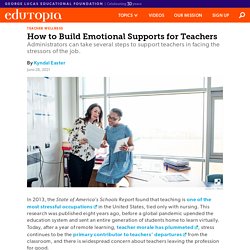
This research was published eight years ago, before a global pandemic upended the education system and sent an entire generation of students home to learn virtually. Today, after a year of remote learning, teacher morale has plummeted, stress continues to be the primary contributor to teachers’ departures from the classroom, and there is widespread concern about teachers leaving the profession for good. At the same time, we are facing a mental health crisis among young Americans, as mental health–related emergency room visits for young children increased significantly last year.
Ten Tips for Building Teacher Resiliency - ASCD Inservice. In July, I wrote “Building Resiliency in Struggling Students: 7 Key Ideas from the Research.”
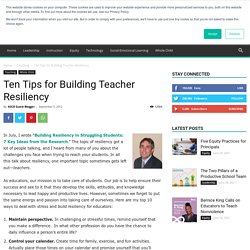
The topic of resiliency got a lot of people talking, and I heard from many of you about the challenges you face when trying to reach your students. In all this talk about resiliency, one important topic sometimes gets left out—teachers. As educators, our mission is to take care of students. Our job is to help ensure their success and see to it that they develop the skills, attitudes, and knowledge necessary to lead happy and productive lives. However, sometimes we forget to put the same energy and passion into taking care of ourselves.
How Resilient Are You? Resources for Building Community Partnerships. Discover Benefits of Community and Business Partnerships How Can High-Poverty Schools Engage Families and the Community?
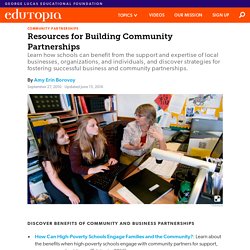
: Learn about the benefits when high-poverty schools engage with community partners for support, resources, and guidance. How Schools Can Successfully Partner with Local Businesses. Businesses have a vested interest in their communities.

They need a strong pool of local workers to choose from and consumers who can afford their products. Many businesses want to give to the community and invest in it, but sometimes they aren’t sure where to start. Schools can also benefit from these partnerships, providing students with opportunities for success in the workforce. Charlie Katz, Director of Corporate Engagement at the National Academy Foundation (NAF), a network of 500 academies serving over 60,000 students across the United States, says that business partnerships can address the new Three Rs: rigor, relevance, and relationships. Think you’re not biased? Think again.pdf. Adopted tpes 2016. How to Collaborate With Parents to Improve Student Learning. Parent-teacher-student collaboration is crucial for student success not only in the classroom but also in life.
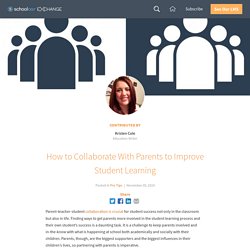
Finding ways to get parents more involved in the student learning process and their own student’s success is a daunting task. It is a challenge to keep parents involved and in-the-know with what is happening at school both academically and socially with their children. Parents, though, are the biggest supporters and the biggest influences in their children’s lives, so partnering with parents is imperative. Communicate Often. Teamwork: Parents and Teachers Working Together. Carol Gooch, M.S., LPC, LCDC, LMFT As a former school teacher and school counselor and currently a mental health professional, I know the importance of teachers and parents working together to foster the success of their students.
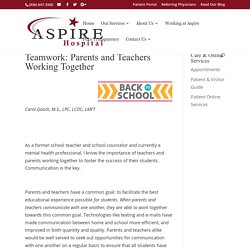
Communication is the key. Parents and teachers have a common goal: to facilitate the best educational experience possible for students. Edvoice06 03 paraprofessionals. 20 Bible Verses about Bullying - Encouraging Scripture Quotes. Restorative Practices 8 28 2015. Data: 5 Big Challenges in Preparing K-12 Students for the World of Work. Once a month, students at Coxsackie-Athens High School near Albany, N.Y., can have a pizza lunch with local employers, including a national pharmaceutical company and an HVAC organization.
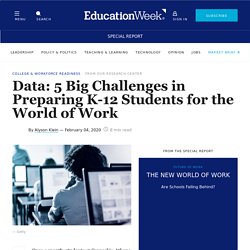
A high school near Detroit that offers students a choice of career specialties recently added a Geographic Information Systems option, so that students can better compete for jobs managing drones and self-driving cars. A middle school in western Massachusetts requires all 7th graders to take a 45-day engineering design course, and all 8th graders to take a similar length “Computing for Innovation” course. Those efforts are a part of a big national push to include much stronger workforce connections in K-12 by revamping curriculum and school culture to help students explore potential careers—including some that their teachers, principals, and district leaders can’t even imagine yet.
Preparing students for the future of work may sound like a no-brainer. The importance of school, community partnerships. I am a firm believer that schools and community are one unit and partnerships with all sectors of the community are essential to helping children reach their maximum potential. Community collaboration with schools complements and reinforces values, culture and the learning opportunities that schools can provide for their students. In other words, all of us — teachers, staff parents, business, nonprofit, service clubs and the like — working together, truly make a difference in the lives of our students.
Beginning my third month as superintendent of San Bruno Park School District, I am very impressed with the past two years of concerted effort by the district to better connect with city and county leadership, service clubs, the nonprofit sector, the Chamber of Commerce and the business and corporate community. The results have been awards and grants, donations, programs, projects and partnerships that are flourishing. Building Community With Restorative Circles. Restorative circles are most effective when they’re an integral part of school culture. After all, you can’t “restore” a community that you haven’t built or sustained. 7 Steps for Facilitating Meaningful Circles 1. Teaching - The doctrine of in loco parentis. When minor children are entrusted by parents to a school, the parents delegate to the school certain responsibilities for their children, and the school has certain liabilities.
In effect, the school and the teachers take some of the responsibility and some of the authority of the parents. The exact extent and nature of this responsibility and power vary from one society to another and from one school system to another. This is spelled out to some extent in the law, but much of it is determined by local custom and practice. There is, of course, a relation between the age of the child on the one hand and the teacher’s responsibility and liability for it on the other. New Teachers: Working With Parents. Back-to-School Night 2.0: Supercharge your delivery and find new ways to engage and connect with students’ families using some of these technology suggestions. (Edutopia, 2015) A Checklist for Back-to-School Night: Explore five ideas for the big night: sign-ins on tables, brochures, a classroom constitution, a presentation, and an inviting classroom environment. (Edutopia, Updated 2015) Back-to-School Night: The Ultimate Conversation Starter for a Successful School Year: Review guidance on how to start the year right by being transparent, direct, and consistent.
(Edutopia, Updated 2015) Engaging Parents: An Elementary Teacher's Field Guide: Reflect on what matters most to parents at back-to-school night, and consider ways to engage more deeply. 25 Ways Teachers Can Integrate Social-Emotional Learning. If there’s anything the past year in education has made painfully obvious, it is the urgency of social-emotional education for our students.
Kids need support and instruction to manage successfully in school (whether that’s in person or online) and in life. Skills like recognizing and managing emotions, being a good friend, controlling impulses, communicating effectively, and working with others are invaluable.